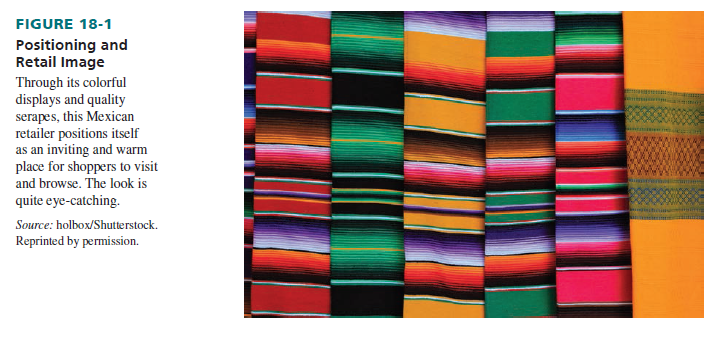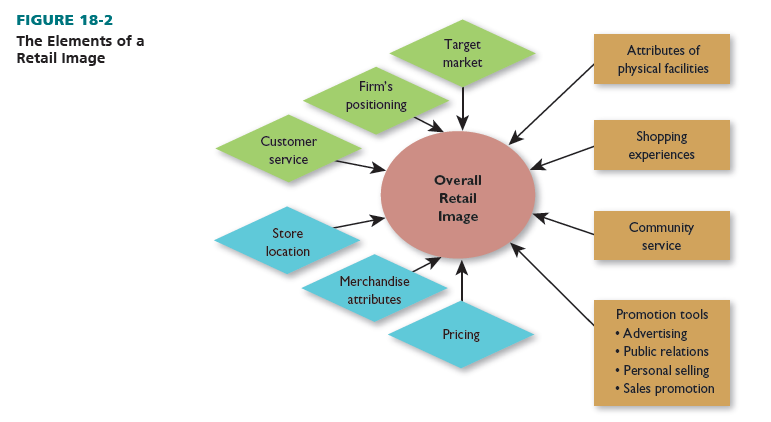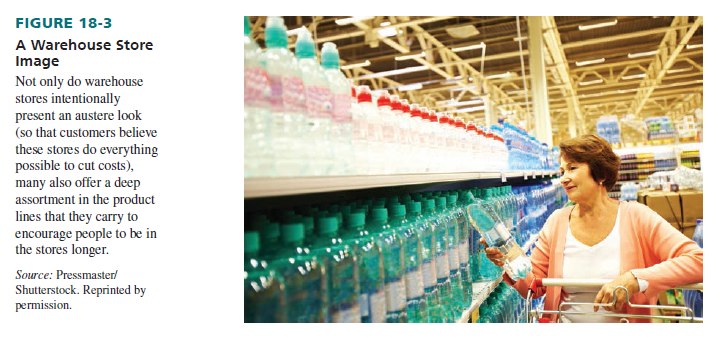Image refers to how a retailer is perceived by customers and others, and positioning refers to how a firm devises its strategy so as to project an image relative to its retail category and its competitors— and to elicit a positive consumer response. To succeed, a retailer must communicate a distinctive, clear, and consistent image. Once its image is established in consumers’ minds, a retailer is placed in a niche relative to competitors. For global retailers, it can be challenging to convey a consistent image worldwide, given the different backgrounds of consumers.
Today’s extensive use of social media by all parties—including customers, the general public, the media, suppliers, brands, and retailers themselves—must be thoroughly understood by retailers and proper strategies proactively enacted. No firm, of any size or type, is immune from the impact of social media content—pro and con—on its image. Social media encompass online technology tools that allow vast numbers of people to easily communicate with one another via the Web and mobile devices. With social media, messages, audio, video, photos, podcasts, and other multimedia communications are possible. Social media are discussed further in Chapter 19.

1. Components of a Retail Image
Many factors contribute to a retailer’s image; it is the totality of them that forms an overall image. See Figure 18-2. We studied these factors in earlier chapters: target market, retail positioning, customer service, store location, merchandise attributes, and pricing. Our focus in this chapter and Chapter 19 is attributes of physical facilities, shopping experiences, community service, advertising, public relations, personal selling, and sales promotion.
2. The Dynamics of Creating and Maintaining a Retail Image
Creating and maintaining a retail image is a complex, multistep, ongoing process. It encompasses far more than store “atmosphere,” which is discussed shortly. Furthermore, with so many people having little time for shopping and others having less interest in it, more retailers understand that they may have to entertain shoppers to draw their business. Here are three examples.

Consider the 145,000-square-foot Bass Pro Shops Outdoor World store in Altoona, Iowa, that includes entertainment features such as archery ranges, miniature shooting ranges, aquariums, and a 3,500-square-foot area with themed artifacts, antiques, pictures, and memorabilia of hunting, fishing, camping, and outdoor recreation. It also has a 15,000-square-foot bowling area—“Uncle Buck’s Fishbowl and Grill”—with 12 10-pin lanes and underwater scenery of sharks, stingrays, and sea turtles that glow in the dark when guests bowl “under the ocean.” A separate upscale “Black Widow Billiards Parlor” features a fireplace with a screen displaying a black widow spider spinning its web. All Pro Bass shops strive to be destination stores with a museum, art gallery, antique store, aquarium, education center, and conservation and entertainment center. The stores engage local communities and customers with taxidermy and wildlife tours, community and Boys Scout events, and seminars and workshops on safely experiencing outdoor adventures.3
Jungle Jim’s International Market, with stores in Ohio (Fairfield and Cincinnati), has grown from a simple roadside stand to two stores, with more than 200,000-square-feet for each store. These stores are food amusement parks and tourist destinations, with over 150,000 different items from over 75 countries around the globe; each store employs an average of 350 employees. Jungle Jim’s has one of the largest wine collections in the United States, live seafood tanks, an instore cooking school, a monorail in its huge parking lot, a gated wildlife preserve with fiberglass animals, and a 1,000-person Oscar Event Center. Scattered around the stores are telephone poles disguised as giraffes that enable customers to speak to a customer service agent. Approximately 80,000 shoppers, known as “Foodies,” visit the stores each week to interact with the animatronic robots that dispense or move products or sing and tell stories about the food in their sections.4
Nordstrom’s new stores have open floor plans with no segregation between departments, designers, or price points, allowing customers to browse seamlessly from one merchandise category to another. These stores are wired for a full digital experience. In-store customers will be able to use a smartphone app to send apparel to a fitting room without having to search through racks. Nordstrom is testing smart fitting-room mirrors with a virtual dressing feature—the mirrors show shoppers how they would look in the clothes without physically wearing them. The mirrors can recommend accessories, such as a scarf to match a dress. The fitting rooms provide videos and side-by-side comparisons of the apparel a shopper tries on. Similar to online retailers, the mirrors can collect data on shopper preferences and how they make decisions if customers opt-in to the feature.5
Retailers can be classified as occupying the following retail image positions based on their leadership on six dimensions (price, location, store interior, product quality, selection, and service): 6
- Price leaders: These retailers focus on low prices and are more apt to offer self-service and a functional store environment. At these retailers, in-store shopping does not go much beyond what consumers can experience online. Examples are Walmart and CVS.
- Location leaders:These retailers are situated at convenient locations; they make their merchandise and services available where customers need them most. Often, they do not offer liberal return policies or present innovative products or displays but that does not concern their customer base. Examples are Dollar General and a local grocery store.
- Atmospherics leaders:These retailers offer an outstanding in-store experience. The firms typically do not carry a wide range of product lines, and prices are higher, commensurate with their image. Examples are Tiffany and Abercrombie & Fitch.
- Product quality leaders:These retailers offer unique, high-quality merchandise and attractive, appealing displays. Examples are Whole Foods and Hallmark/Gold Crown.
- Selection leaders:These retailers offer good value on the wide range of items they sell and are an interesting place to shop. However, they are typically not as exciting as atmosphere leaders. They add new items on a regular basis and encourage shoppers to spend more time. They do a good job in coordinating in-store and online shopping experiences. Examples are Kohl’s and Bed Bath & Beyond.
- Service leaders:These retailers are conveniently located and offer shoppers good customer service. The sales staff has some product expertise, and information is easy to acquire. This type of retailer does not have a very exciting in-store environment. It is a good place to buy items that are planned in advance. Examples are AutoZone and Lowe’s.
Figure 18-3 shows the image presented by a membership (warehouse) store. Retailers in this category are price leaders.

A key goal for chain retailers, franchisors, and global retailers is to maintain a consistent image among all branches and with the Web site. Yet, despite the best planning, a number of factors may vary widely among branch stores and affect the image. They include management and employee performance, consumer profiles, competitors, convenient locations, parking, safety, the ease of finding merchandise, language and cultural diversity among customers in different countries, and the qualities of the surrounding area. Sometimes, retailers with good images receive negative publicity. This must be countered in order for them to maintain their desired standing with the public.
Source: Barry Berman, Joel R Evans, Patrali Chatterjee (2017), Retail Management: A Strategic Approach, Pearson; 13th edition.

Keep working ,terrific job!